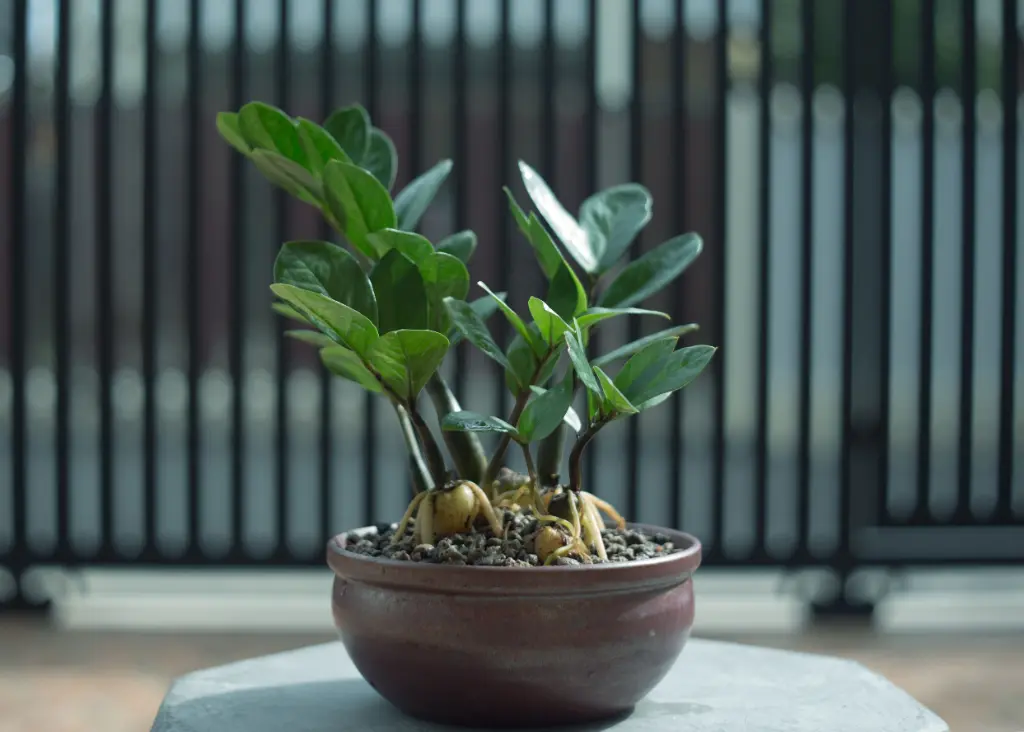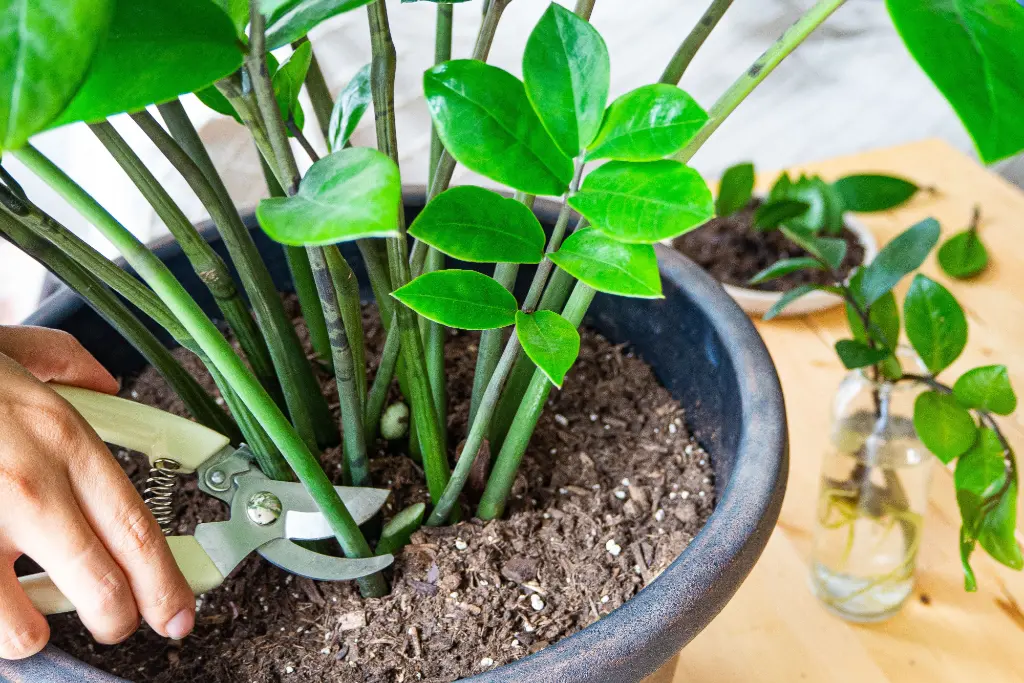The ZZ plant (Zamioculcas zamiifolia) is an ideal choice for both novice and experienced plant enthusiasts. This resilient, low-maintenance plant is known for its glossy, dark green leaves and ability to thrive in a variety of conditions. In this comprehensive guide, we will explore everything you need to know about growing and caring for ZZ plants.
Introduction to ZZ Plants
ZZ plants, also known as Zamioculcas zamiifolia, are native to Eastern Africa. They are highly regarded for their attractive, waxy leaves that reflect light and add a touch of elegance to any room. ZZ plants are also known for their air-purifying qualities, making them a popular choice for homes and offices.
Characteristics
- Scientific Name: Zamioculcas zamiifolia
- Common Names: ZZ plant, Zanzibar gem
- Native Region: Eastern Africa
- Plant Type: Perennial
- Light Requirement: Low to bright indirect light
- Water Requirement: Low, drought-tolerant

Choosing the Right Environment
ZZ plants are incredibly versatile and can adapt to a wide range of environmental conditions. However, providing the ideal environment will ensure optimal growth and health.
Temperature
ZZ plants prefer temperatures between 65°F and 75°F (18°C to 24°C). They can tolerate temperatures as low as 45°F (7°C), but exposure to cold drafts should be avoided.
Humidity
ZZ plants thrive in average household humidity levels, around 40-50%. They can tolerate lower humidity but may benefit from occasional misting in particularly dry environments.
Light
Although ZZ plants can survive in low light conditions, they grow best in bright, indirect light. Direct sunlight can scorch their leaves, so it’s important to provide filtered light.
Planting ZZ Plants
Planting ZZ plants correctly is crucial for their long-term health and growth. Follow these steps for successful planting:
Choosing the Right Pot
- Material: Terra cotta or plastic pots work well.
- Size: Select a pot that is 1-2 inches larger in diameter than the plant’s root ball.
- Drainage: Ensure the pot has drainage holes to prevent waterlogging.
Soil Requirements
ZZ plants prefer well-draining soil. A mix of potting soil, perlite, and sand in equal parts works well. You can also use a cactus or succulent mix.
Planting Steps
- Fill the pot with the soil mixture, leaving enough room for the root ball.
- Gently remove the ZZ plant from its current pot, being careful not to damage the roots.
- Place the plant in the new pot and fill in around the root ball with soil.
- Water lightly to settle the soil.
Watering ZZ Plants
ZZ plants are drought-tolerant and can survive long periods without water. However, proper watering is essential for healthy growth.
Watering Frequency
- Spring and Summer: Water once every 2-3 weeks, allowing the soil to dry out between waterings.
- Fall and Winter: Reduce watering to once a month or less.
Watering Technique
- Water the plant thoroughly until water drains from the bottom of the pot.
- Discard any excess water in the saucer to prevent root rot.
- Avoid getting water on the leaves to prevent fungal issues.
Signs of Overwatering and Underwatering
- Overwatering: Yellowing leaves, soft stems, root rot.
- Underwatering: Brown tips, dry and crispy leaves.
Feeding and Fertilizing
ZZ plants are not heavy feeders, but occasional fertilization can promote healthier growth.
Fertilizer Type
- Use a balanced, water-soluble fertilizer with an N-P-K ratio of 10-10-10 or 20-20-20.
- Dilute the fertilizer to half the recommended strength.
Fertilizing Schedule
- Spring and Summer: Fertilize once a month.
- Fall and Winter: Do not fertilize during the dormant period.
Light Requirements
ZZ plants are adaptable to various light conditions but prefer bright, indirect light for optimal growth.
Ideal Light Conditions
- Bright, Indirect Light: Place near a window with filtered sunlight.
- Low Light: Can survive in low light but will grow more slowly.
Avoiding Direct Sunlight
Direct sunlight can cause leaf burn, so it’s best to place ZZ plants in a spot where they receive indirect light or are shaded by sheer curtains.
Pruning and Maintenance
Pruning ZZ plants helps maintain their shape and encourages new growth.
When to Prune
- Prune in early spring before the growing season begins.
- Remove any yellow, damaged, or dead leaves throughout the year.
How to Prune
- Use clean, sharp scissors or pruning shears.
- Cut the stems at the base, close to the soil line.
- Be careful not to damage healthy stems and leaves.
Repotting ZZ Plants
Repotting ZZ plants every 2-3 years helps refresh the soil and provides more space for growth.
Signs That Your ZZ Plant Needs Repotting
- Roots are growing out of the drainage holes.
- The plant becomes top-heavy and unstable.
- Soil dries out quickly after watering.
Repotting Steps
- Choose a pot that is 1-2 inches larger in diameter than the current pot.
- Fill the new pot with a fresh soil mixture.
- Gently remove the ZZ plant from its current pot and shake off excess soil.
- Place the plant in the new pot and fill in with soil around the root ball.
- Water thoroughly to settle the soil.
Common Problems and Solutions
While ZZ plants are generally hardy, they can encounter a few common issues.
Yellowing Leaves
- Cause: Overwatering, poor drainage.
- Solution: Reduce watering frequency and ensure the pot has proper drainage.
Brown Tips
- Cause: Underwatering, low humidity.
- Solution: Increase watering frequency and mist the plant occasionally.
Pests
- Common Pests: Spider mites, mealybugs.
- Solution: Wipe the leaves with a damp cloth and use insecticidal soap if necessary.
Root Rot
- Cause: Overwatering, poor drainage.
- Solution: Remove affected roots, repot in fresh soil, and adjust watering habits.
Seasonal Care Guide
Here’s a handy seasonal guide to help you manage your ZZ plant care throughout the year:
| Month | Jan | Feb | Mar | Apr | May | Jun | Jul | Aug | Sep | Oct | Nov | Dec |
|---|---|---|---|---|---|---|---|---|---|---|---|---|
| Watering | yes | yes | yes | yes | yes | yes | yes | yes | yes | yes | yes | yes |
| Fertilizing | no | no | yes | yes | yes | yes | yes | yes | no | no | no | no |
| Pruning | no | no | yes | yes | no | no | no | no | no | no | no | no |
| Repotting | no | no | no | no | no | no | no | no | no | no | yes | yes |
Propagation Methods

ZZ plants can be propagated through division or leaf cuttings.
Division
- Remove the plant from its pot and gently separate the rhizomes (underground stems).
- Ensure each division has at least one stem and several roots.
- Plant each division in its own pot with fresh soil.
Leaf Cuttings
- Cut a healthy leaf from the plant.
- Allow the cutting to dry for a few hours to form a callus.
- Plant the leaf cutting in moist soil, burying the base about an inch deep.
- Keep the soil lightly moist and place the pot in bright, indirect light.
- Roots and new shoots will develop in a few months.
ZZ Plants in Interior Design
ZZ plants are popular in interior design due to their striking appearance and low maintenance needs. They are perfect for adding greenery to offices, living rooms, and other indoor spaces.
Design Tips
- Containers: Use stylish pots or planters that complement your decor.
- Placement: Place ZZ plants on shelves, tables, or floor stands to add visual interest.
- Grouping: Combine ZZ plants with other low-light plants for a lush, green display.
FAQs
Can ZZ plants tolerate low light?
Yes, ZZ plants can tolerate low light conditions but will grow more slowly. For optimal growth, place them in bright, indirect light.
How often should I water my ZZ plant?
Water ZZ plants once every 2-3 weeks during spring and summer, and reduce watering to once a month during fall and winter.
Are ZZ plants toxic to pets?
Yes, ZZ plants are toxic if ingested by pets and humans. Keep them out of reach of children and pets.
Why are the leaves of
my ZZ plant turning yellow?
Yellow leaves are often a sign of overwatering. Ensure the pot has proper drainage and adjust your watering schedule.
Can I propagate ZZ plants in water?
While it is possible to propagate ZZ plants in water, soil propagation is more reliable and produces stronger plants.
Conclusion
ZZ plants are an excellent choice for anyone looking to add a touch of greenery to their home or office with minimal effort. By following the guidelines in this comprehensive guide, you can ensure your ZZ plant thrives and remains a beautiful addition to your indoor garden. Happy planting!



